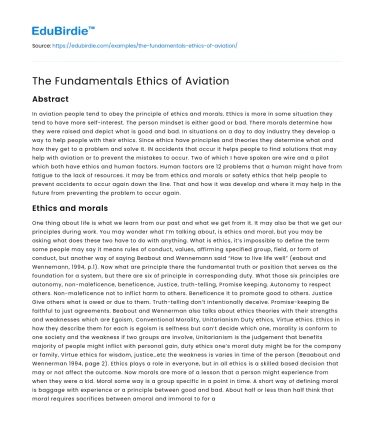Introduction
The aviation industry, a cornerstone of modern global transportation, operates under a complex framework of ethical principles that ensure safety, efficiency, and environmental sustainability. The fundamental ethics of aviation encompass a broad spectrum of considerations, including the moral responsibilities of airlines, regulatory bodies, and individual aviation professionals. These ethical guidelines are critical in navigating the multifaceted challenges posed by technological advancements and increasing global connectivity. In this essay, we will explore the essential ethical principles guiding aviation, focusing on safety protocols, the environmental impact of air travel, and the role of personal integrity among aviation professionals. By examining real-life cases and expert opinions, we aim to highlight the importance of maintaining ethical standards in fostering trust and accountability within the aviation sector.
The aviation industry’s reliance on ethical practices is not merely theoretical but is rooted in practical applications that affect millions of lives daily. A nuanced understanding of these principles is vital for ensuring that the rapid growth of air travel does not compromise the welfare of passengers and the broader global community. Through this exploration, we will also consider counter-arguments to reinforce the necessity of upholding ethical standards in aviation.
Safety Protocols and Ethical Responsibility
Safety is the bedrock of aviation ethics, encompassing the duty of care owed to passengers, crew, and the public. The adherence to strict safety protocols is not only a legal obligation but a moral imperative. According to the International Civil Aviation Organization (ICAO), safety management systems (SMS) are essential in identifying potential hazards and implementing strategies to mitigate risks. For instance, the tragic accidents of Boeing 737 Max flights in 2018 and 2019 underscore the critical need for rigorous safety oversight and transparent communication between manufacturers, airlines, and regulatory bodies. In response to these incidents, ethical scrutiny intensified, prompting a reevaluation of safety practices and the importance of prioritizing human lives over corporate interests.
Furthermore, the incorporation of advanced technologies such as artificial intelligence and automation in aviation presents new ethical challenges. While these innovations promise enhanced safety and efficiency, they also raise concerns about reliability and accountability. Experts argue that as technology advances, the ethical responsibility of ensuring safety must evolve accordingly. For example, the integration of AI-driven systems in aircraft necessitates robust ethical frameworks to address potential failures and ensure human oversight remains central to decision-making processes. Thus, balancing technological progress with ethical safety considerations is paramount in maintaining public trust in aviation.
Environmental Considerations in Aviation Ethics
The environmental impact of aviation is a growing ethical concern, given the industry's significant contribution to global carbon emissions. Aviation accounts for approximately 2-3% of global CO2 emissions, prompting calls for sustainable practices to mitigate its environmental footprint. Ethical responsibility in this context involves not only regulatory compliance but proactive measures to reduce emissions through technological innovation and operational efficiency. The adoption of sustainable aviation fuels (SAF) and the development of energy-efficient aircraft designs are examples of how the industry is addressing its environmental responsibilities.
However, implementing these measures is not without challenges. The economic implications of transitioning to greener technologies can be substantial, raising questions about the feasibility and fairness of such initiatives. Critics argue that the high costs associated with sustainable practices may disproportionately affect smaller airlines and developing nations, potentially leading to inequities in the industry. To counter these arguments, it is essential to promote collaborative efforts among stakeholders, including governments, airlines, and environmental organizations, to develop equitable solutions that balance economic and environmental considerations. By fostering a collective ethical commitment to sustainability, the aviation industry can contribute positively to global climate goals.
The Role of Personal Integrity in Aviation
Personal integrity among aviation professionals is another fundamental aspect of aviation ethics. The trust placed in pilots, air traffic controllers, and maintenance crews is immense, as their decisions directly impact the safety and well-being of passengers. Ethical behavior in this context involves adherence to professional standards, continuous training, and a commitment to transparency and honesty. The case of Captain Chesley "Sully" Sullenberger, who successfully landed US Airways Flight 1549 on the Hudson River in 2009, exemplifies the critical role of personal integrity in crisis situations. Sullenberger's professionalism and ethical decision-making under pressure serve as a benchmark for aviation conduct.
Counterarguments suggest that excessive focus on individual integrity may overlook systemic issues within the industry that also contribute to ethical lapses. However, fostering a culture of ethical accountability at both the individual and organizational levels is not mutually exclusive. Encouraging open communication, reporting of unethical practices, and implementing comprehensive training programs are ways to nurture integrity across the aviation sector. By addressing both individual and systemic ethical challenges, the industry can enhance its overall ethical standards and reinforce public confidence.
Conclusion
In conclusion, the fundamental ethics of aviation are integral to ensuring the industry's safety, sustainability, and integrity. By upholding stringent safety protocols, addressing environmental impacts, and fostering personal integrity among aviation professionals, the industry can navigate the ethical challenges posed by technological advancements and global expansion. The balance between progress and ethical responsibility is crucial, requiring ongoing dialogue and collaboration among stakeholders to address emerging issues and reinforce ethical standards. As the aviation industry continues to evolve, its commitment to ethical principles will remain essential in maintaining trust and accountability, ultimately safeguarding the well-being of passengers and the global community.
Through real-life examples and expert insights, this essay highlights the importance of ethical considerations in shaping the future of aviation. By addressing counterarguments and advocating for a holistic approach to ethics, we reinforce the necessity of maintaining ethical standards in fostering a safe, sustainable, and trustworthy aviation industry. As such, the ethical foundations of aviation are not merely theoretical constructs but practical imperatives that ensure the welfare of all who rely on air travel.






 Stuck on your essay?
Stuck on your essay?

